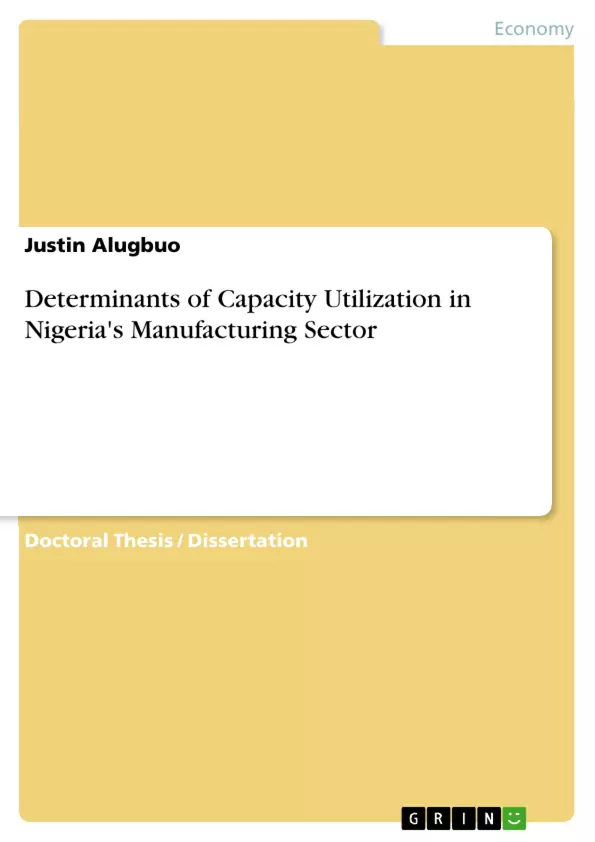The study investigated the effect of the determinants of capacity utilization in Nigeria’s manufacturing sector. The objectives of the study was to determine effect of electricity power consumption, lending interest rate, total labour force, bank credit to manufacturing industries and gross capital formation on average manufacturing capacity utilization rate in Nigeria. The study utilized annual time series data obtained from World Development Indicators (WDI) for the period 1981-2019 with the help of the Auto Regressive Distributive Lag (ARDL) model of estimation.
Inhaltsverzeichnis (Table of Contents)
- CHAPTER ONE: INTRODUCTION
- 1.1 Background to the study
- 1.2. Statement of the Problem
- 1.3 Objectives of the Study
- 1.4 Research Questions
- 1.5 Research Hypotheses
- 1.6 Significance of the Study
- 1.7 Scope of the Study
- CHAPTER TWO: LITERATURE REVIEW
- 2.1. Conceptual Framework
- 2.1.2 Capacity Utilization
- 2.1.2.1. Measurement of Capacity Utilization
- 2.1.3 Electricity Generation Rate in Nigeria
- 2.1.4 Gross Fixed Capital formation
- 2.1.5 Lending Interest Rate in Nigeria
- 2.1.5.1 Management of Interest rate in Nigeria
- 2.1.6 Imported Goods in Nigeria
- 2.1.6.1 Growth Rate of Imported Goods in Nigeria
- 2.1.6.2 Trade Policy Trend - Import control measures
- 2.1.7. Labour Force and Labour Market in Nigeria
- 2.1.8 Commercial Bank Credits/Loans to Nigeria Manufacturing Sector
- 2.1.9 Overview of the Nigerian Manufacturing Sector
- 2.1.9.1 Contributions of Manufacturing Industries to Growth and Development of Nigeria
- 2.1.9.2 Determinants of Manufacturing Production in Nigeria
- 2.1.9.3 Problems of the Manufacturing Sector in Nigeria
- 2.1.9.4 An Overview of Manufacturing Policies in Nigeria
- 2.1.9.5 Productivity in the Nigerian Manufacturing Industry
- 2.1.9.6 Globalization and the manufacturing sector in Nigeria
- 2.1.9.7 The performance of Nigerian manufacturing firms
- 2.2 Theoretical Literature Review
- 2.2.1 The Classical Growth Theory
- 2.2.2 Keynesian Theory of Economic Growth
- 2.2.3 Theory of Production
- 2.2.4 The Neoclassical Growth Theory
- 2.2.5 The Endogenous Growth Theory
- 2.2.5.1 The Arrow Model
- 2.2.5.2 The Levhari-Sheshinski Model
- 2.2.5.3 The King-Robson Model
- 2.2.5.4 The Romer Model
- 2.2.5.5 The Lucas Model
- 2.2.5.6 Romer's Model of Technological Change
- 2.2.6 Structural Change Theory
- 2.4 Empirical Literature Review
- The role of electricity supply in driving manufacturing output.
- The impact of interest rates on capacity utilization and industrial growth.
- The relationship between labor force and manufacturing capacity.
- The influence of bank credit availability on manufacturing activity.
- The contribution of capital formation to manufacturing capacity expansion.
Zielsetzung und Themenschwerpunkte (Objectives and Key Themes)
This dissertation explores the factors affecting capacity utilization in Nigeria's manufacturing sector. The primary goal is to determine the impact of key variables such as electricity consumption, lending interest rates, total labor force, bank credit, and capital formation on average capacity utilization in the manufacturing industry.
Zusammenfassung der Kapitel (Chapter Summaries)
Chapter One provides an introduction to the study, outlining the background, research problem, objectives, research questions, hypotheses, significance, and scope of the dissertation. Chapter Two delves into the literature review, examining relevant conceptual frameworks, theoretical perspectives, and empirical studies related to capacity utilization in the manufacturing sector.
Schlüsselwörter (Keywords)
This dissertation focuses on capacity utilization, manufacturing sector, electricity consumption, interest rates, labor force, bank credit, capital formation, economic growth, and development in Nigeria.
- Citar trabajo
- Justin Alugbuo (Autor), 2022, Determinants of Capacity Utilization in Nigeria's Manufacturing Sector, Múnich, GRIN Verlag, https://www.grin.com/document/1175869



